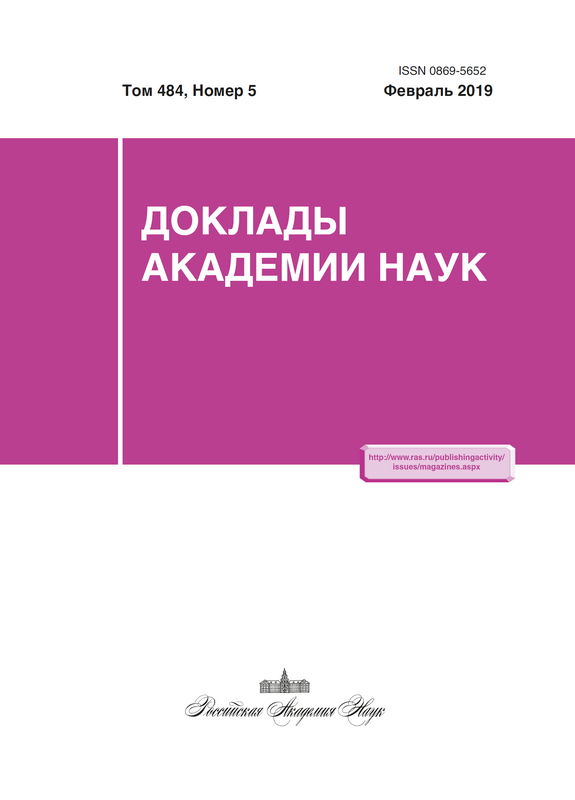The physical nature of heterogeneity of the composition of river water
- Authors: Chashechkin Y.D.1, Rosenthal O.M.2
-
Affiliations:
- Ishlinsky Institute for Problems in Mechanics of the Russian Academy of Sciences
- Water Problems Institute of the Russian Academy of Sciences
- Issue: Vol 484, No 5 (2019)
- Pages: 605-609
- Section: Geochemistry
- URL: https://journals.eco-vector.com/0869-5652/article/view/12781
- DOI: https://doi.org/10.31857/S0869-56524845605-609
- ID: 12781
Cite item
Abstract
Experimental data are presented to show that the spatial and temporal variability of the composition of river waters cannot be explained solely by the influence of sources and effluents of the substances and that there are additional significant factors that support or even initiate the dispersion of the concentration of pollutants here. This variation is reflected in the resources and the economic characteristics of the rivers; so identification of its reason is important. Thus, the hydrodynamic structure of the water flow is studied by analyzing the complete system of equations of fluid motion mechanics. The completed work allowed us to show that the elements of this structure are waves, vortices, and highly gradient layers (ligaments), presumably creating the described dispersion effect. Further investigation of the relationship of the precise hydrodynamic and hydrochemical structures of river waters will contribute to better understanding of the water-environmental processes, ensuring the perfection of water management methods.
About the authors
Yu. D. Chashechkin
Ishlinsky Institute for Problems in Mechanics of the Russian Academy of Sciences
Author for correspondence.
Email: chakin@ipmnet.ru
Russian Federation, Moscow
O. M. Rosenthal
Water Problems Institute of the Russian Academy of Sciences
Email: chakin@ipmnet.ru
Russian Federation, Moscow
References
- Реки и озера мира. Энциклопедия / Под ред. В.И. Данилов-Данильяна. М.: Энциклопедия, 2012. 925 с.
- https://www.tripadvisor.ru/ShowUserReviews-g303235-d554183-r229755948.
- Rozental O.M., Averbuсh A.I. Water Resources Development: Economic and Legal Aspects // Introduction Water Qualimetry. 2013. V. 40. № 4. P. 447–461.
- Grill S., Zykov V.S., Muller S.C. Feedback Controlled Dynamics of Meandring Spiral Waves // Phys. Rev. Lett. 1995. V. 75. № 18. P. 3368–3371.
- Rossi F., Vanag V.K., Epstein I.R. Pentanary Cross-Diffusion in Water-inOil Microemulsions Loaded with Two Components of the BelousovZhabotinsky Reaction// Chemistry. 2013. V. 17. № 7. P. 2138–2145.
- Hou M.J., Shah D.O. Effects of the Molecular Structure of the Interface and Continuous Phase on Solubilization of Water in Water/Oil Microemulsions// Langmuir. 1987. V. 3. P. 1086–1096.
- Anikeenko A.V., Malenkov G.G., Naberukhin Yu.I. Visualization of the Collective Vortex-Like Motions in Liquid Argon and Water: Molecular Dynamics Simulation // J. Chem. Phys. 2018. V. 148. № 9. P. 1660–1662.
- Аникеенко А.В., Наберухин Ю.И. Крупномасштабные и долговременные корреляции в коллективных движениях атомов жидкого аргона. Компьютерное моделирование // Письма в ЖЭТФ. 2017. T. 106. № 5. C. 269–274.
- Зицерман В.Ю. Махновский Ю.А., Трахтенберг Л.И. и др. Дрейф частиц, обусловленный флуктуациями их размера // Письма в ЖЭТФ. 2017. Т. 105. № 5. С. 315–321.
- Chashechkin Yu.D. Differential Fluid Mechanics – Harmonization of Analytical, Numerical and Laboratory Models of Flows // Math. Modeling and Optim. of Complex Struct. Springer Ser. Computat. Methods in Appl. Sci. 2016. V. 40. P. 61–91.
- Зоммерфельд А. Термодинамика и статистическая физика. М.: Изд-во иностр. лит., 1955. 482 с.
- Ландау Л.Д., Лифшиц Е.М. Теоретическая физика. Т. 6. Гидродинамика. М.: Наука, 1986. 736 с.
- Sukharev Yu.I., Markov B.A. Liesegang Operator. Liesegang Rings as the Common Gross–Property of Oxyhydrate Gel Polymer Systems. The Chemistry Preprint Server. 7 April 2000. http://preprint.chemweb.com/physchem/0104005.
Supplementary files







